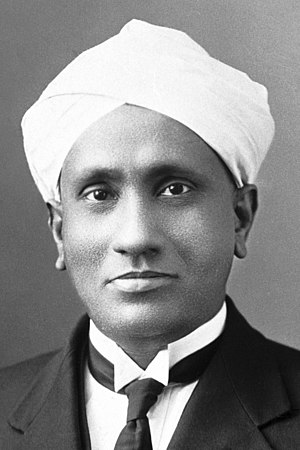De Wikipedia, le encyclopedia libere
| Chandrasekhara Venkata Raman |
|---|
 |
| Sexo |
mascule |
|---|
| Nascentia |
1888-11-07 (Tiruchirappalli) |
|---|
| Decesso |
1970-11-21 (Bengaluru) |
|---|
| Citatania |
British Raj[*], India, Dominion of India[*] |
|---|
| Educate in |
University of Madras[*], Presidency College[*], University of Calcutta[*] |
|---|
| Occupation |
physico, professor universitari[*], crystallographer[*] |
|---|
| Obras notabile |
A New Type of Secondary Radiation[*], Raman scattering[*] |
|---|
| Religion |
Hinduismo |
|---|
| Conjuge |
Lokasundari Ammal[*] |
|---|
| Infantes |
Venkatraman Radhakrishnan[*], Chandrasekhar (Raja) Raman[*] |
|---|
| Parentes |
matre Parvathi Ammal[*] patre R. Chandrasekhara Iyer[*] |
|---|
| Fratres/sorores |
CS Ayyar[*], Mangalam[*], Kumaraswamy (Skandan)[*], Sundaram[*], Sitalaxmi[*], Meena[*], Ramaswamy[*] |
|---|
| Premios |
Premio Nobel pro Physica, Lenin Peace Prize[*], Bharat Ratna[*], Fellow of the Royal Society[*], Hughes Medal[*], Matteucci Medal[*], Franklin Medal[*], honorary doctor of the University of Calcutta[*], Knight Bachelor[*], Matteucci Medal[*], Hughes Medal[*], Honorary Fellow of the Royal Society Te Apārangi[*], honorary doctor of the University of Bordeaux[*], doctor honoris causa from the University of Paris[*] |
|---|
| Lingua |
anglese |
|---|
| Signatura |
 |
|---|
| Identificatores |
|---|
| ISNI |
0000000108724554 |
|---|
| VIAF |
14901832 |
|---|
| Commons |
C. V. Raman |
|---|
Sir Chandrasekhara Venkata Raman o C.V. Raman, (7 de novembre 1888 in Tiruchirappalli, India – 21 de novembre 1970 in Bangalore, India) esseva un physico indian e un ganiator del Premio Nobel.
In 1930 ille ha recipite le Premio Nobel pro Physica pro su travalio super le dispersion del lumine e discoperta del Effecto Raman.[1] In 1957 ille esseva premiate le Premio Lenin del Pace. Ille esseva alsi le oncle del physico e ganiator del Premio Nobel pro Physica Subrahmanyan Chandrasekhar.
 Nota
Nota



